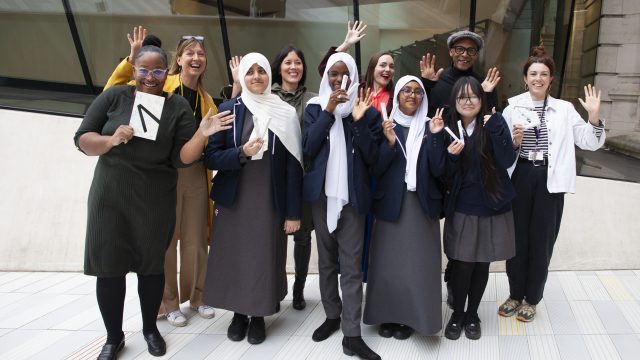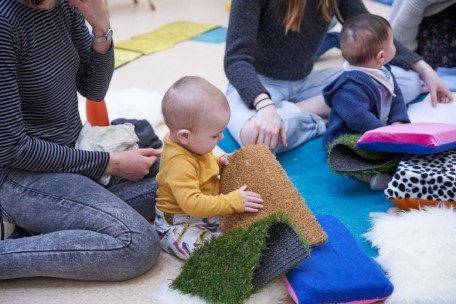
Luca della Robbia, October; The Labours of the Months, Florence, Italy, Tin-glazed terracotta, Medieval and Renaissance Galleries, Room 64, Case SS, Mus Ref: 7641-1861 © Victoria and Albert Museum, London
This week’s object is an exceptional example of Italian renaissance interior decoration: in terms of design and materials there’s nothing quite like it, even in Italy, let alone in a British collection, and its provenance makes it still more special. It’s the ceiling from the studietto (private study) of the Medici Palace in Florence, and apart from the famous Chapel of the Magi by Benozzo Gozzoli, still in situ, it’s the only element of the palace’s magnificent interior to have survived. Created for Piero de’ Medici in the 1450s, the studietto was a small, intimate room, intended for study and contemplation, but also for display. Here were kept the most precious objects in the Medici’s collection: costly illuminated books, classical coins, cameos and vases, medieval ivories and goldsmiths’ work, and a tiny painting by the great Netherlandish master Jan van Eyck. Piero, who suffered from gout and was often confined indoors, is said to have taken great delight in being carried to his studietto, whiling away the hours in contemplating all these objects. At the V&A, this space has been recreated, with objects of the sort that the Medici owned displayed beneath the tiles from the original ceiling. Its barrel-vaulted form – which the curvature of the tiles has made it possible to reconstruct – is suggestive of being inside a treasure-casket.
The ceiling is by the sculptor Luca della Robbia (1399-1482), and consists of twelve roundels depicting the Labours of the Months. It employs the technique of tin-glazed terracotta, developed by Della Robbia around 1430 for architectural sculpture, and for which his workshop was famous, although its use in a domestic context is exceptional. Also exceptionally, the designs are naturalistically painted rather than sculpted, in shades of white and blue, a difficult, experimental technique that was never apparently repeated. Only the edges of the roundels are sculpted, with a leaf pattern in low relief. They were originally set into a pattern of green and purple tiles, fragments of which are still visible around the edges of the roundels, which were intended to stand for the Medici colours of red and green, the purple glaze being the closest approximation possible to red in this technique, at this date. The ceiling was intended to strike a lavish and highly unusual note, perfectly complementing the precious rarities housed beneath it.

Luca della Robbia, June; The Labours of the Months, Florence, Italy, Tin-glazed terracotta, Medieval and Renaissance Galleries, Room 64, Case SS, Mus Ref: 7637-1861 © Victoria and Albert Museum, London
Each of the twelve roundels depicts one of the Labours of the Months associated with the activities of the agricultural calendar. This tradition goes back to classical antiquity, and was widely depicted in the medieval era – for instance on the exteriors of cathedrals, signifying the natural order of the cosmos, or in the calendar pages of prayer books – but also reflects contemporary agricultural practice. For instance, April shows the training of vines; June the reaping of corn; August, a farmer ploughing; September, harvesting grapes; October, sowing; November, harvesting olives, and so on. Around the edge of each roundel a band of light and dark blue denotes the relative periods of light and darkness, which varies according to the month depicted: in the summer, the light blue band is considerably longer than the dark. The hours of daylight are inscribed in Latin inscriptions, with the words DIES (days) and ORE (hours). In the light blue bands is the sun, panted in yellow glaze, with the appropriate sign of the zodiac, and in the dark blue area opposite, a crescent moon. The theme of the Labours of the Months is an interesting choice for the ceiling of the studietto; the changeless cycle of the seasons and its association with the natural order might be interpreted as a metaphor for the continuity and order of the Medici regime; Piero de’ Medici’s motto, perhaps significantly in this context, was SEMPER (‘always’).

Luca della Robbia, September; The Labours of the Months, Florence, Italy, Tin-glazed terracotta, Medieval and Renaissance Galleries, Room 64, Case SS, Mus Ref: 7640-1861© Victoria and Albert Museum, London
Around 1465 the Florentine architect Filarete described the studietto as decorated ‘with most worthy figures, so that everyone who entered was filled with admiration’. The room was destroyed when the Medici Palace was remodelled in the seventeenth-century; the roundels were purchased for the V&A in 1861, from an Italian private collection. In its present reconstruction it is one of the most evocative spaces in the V&A, enabling the modern visitor to recapture the intimacy of the original room, and like the first visitors, to admire its beautiful decoration.
“Twenty Objects for Twenty Years” is a series of articles written by Paula Nuttall, Director of the Late Medieval to Early Renaissance Year Course, exploring some of her favourite pieces in the V&A’s extensive Renaissance collections. You can find the rest of the series along with other posts from the Learning Department at the V&A on their blog.


